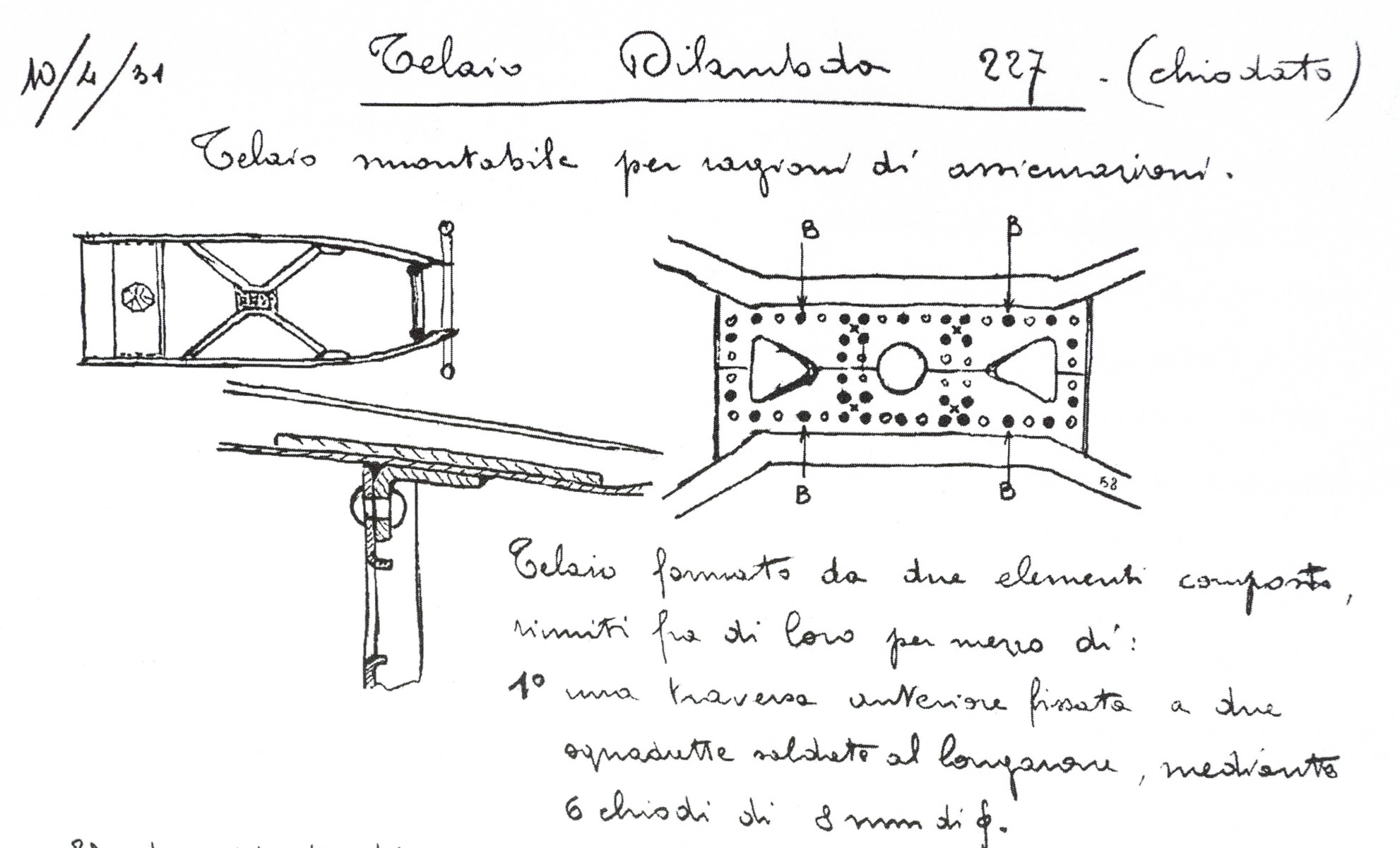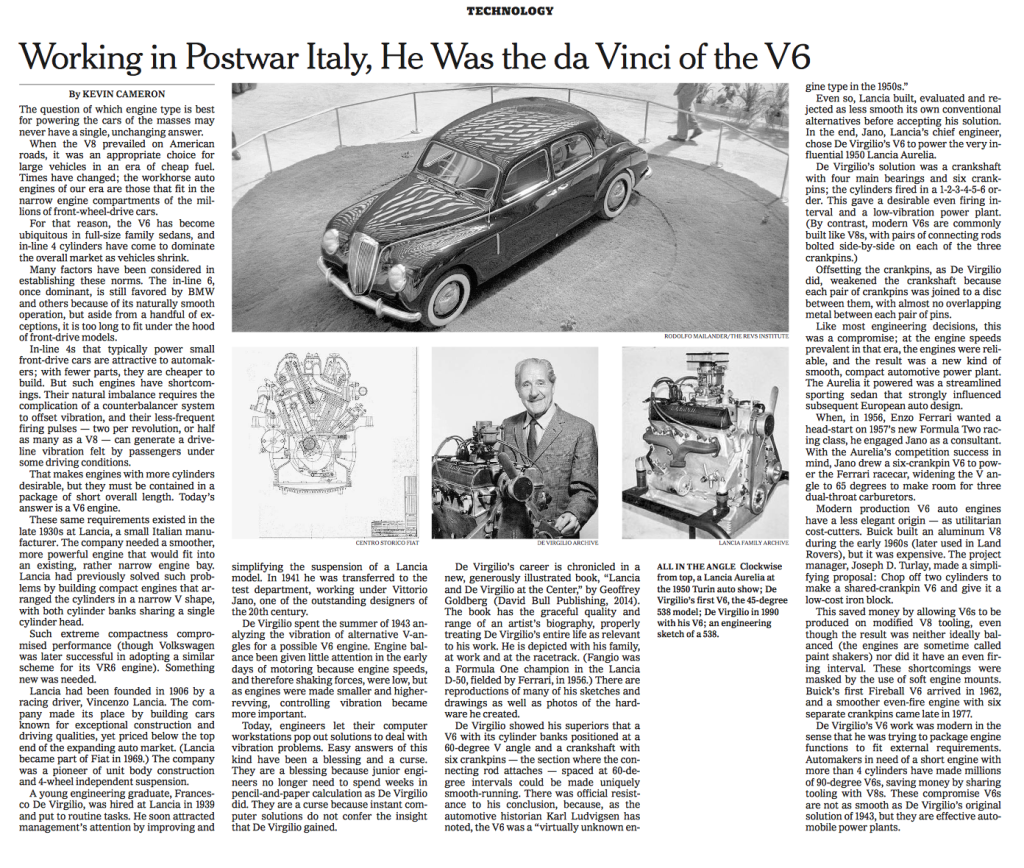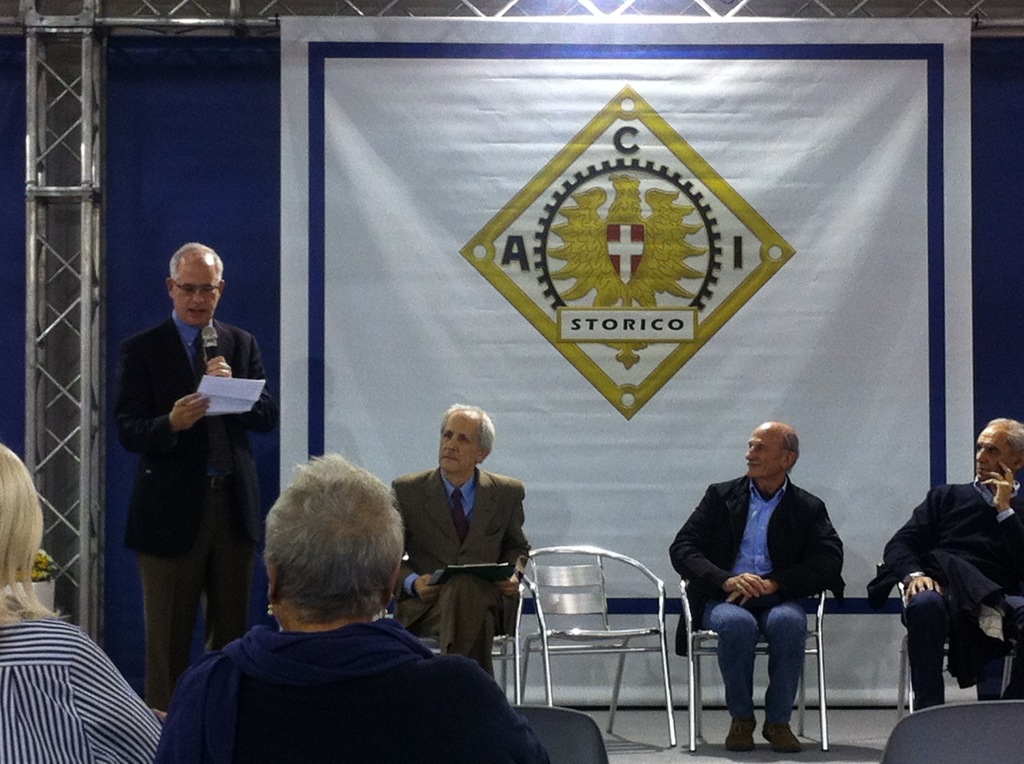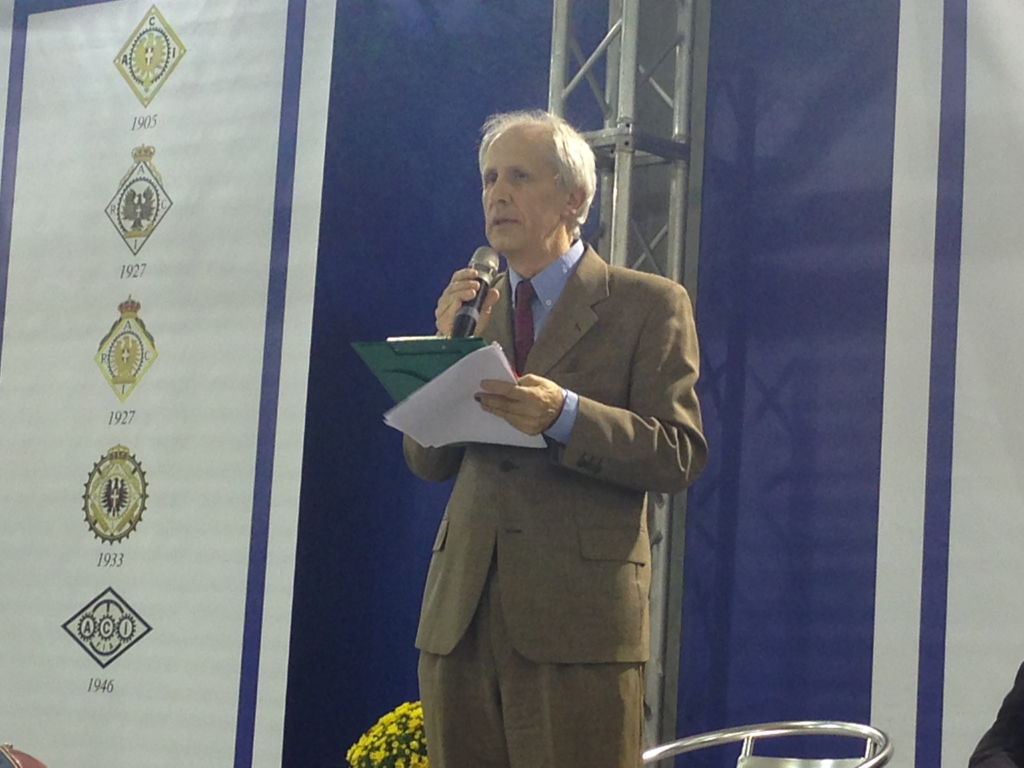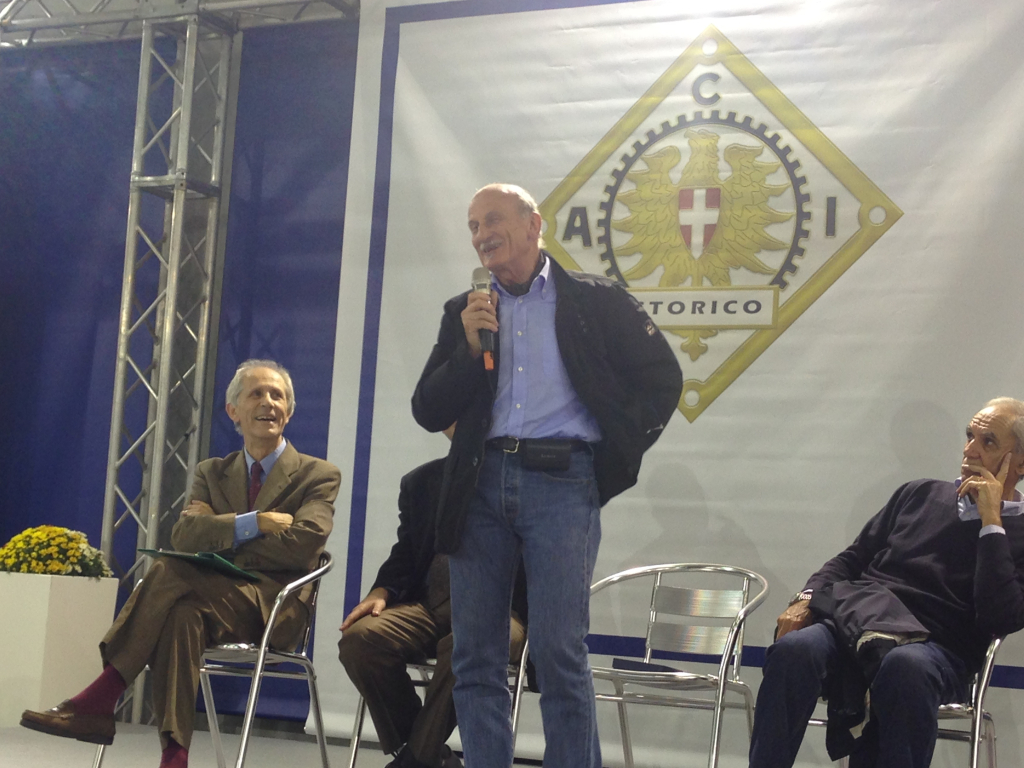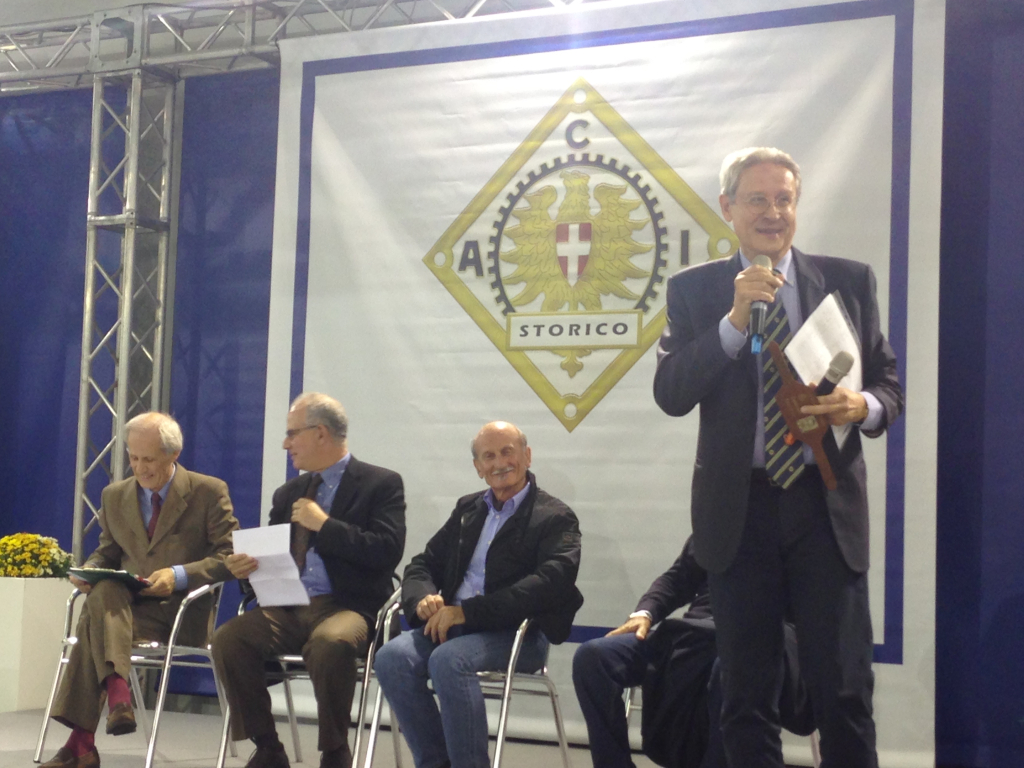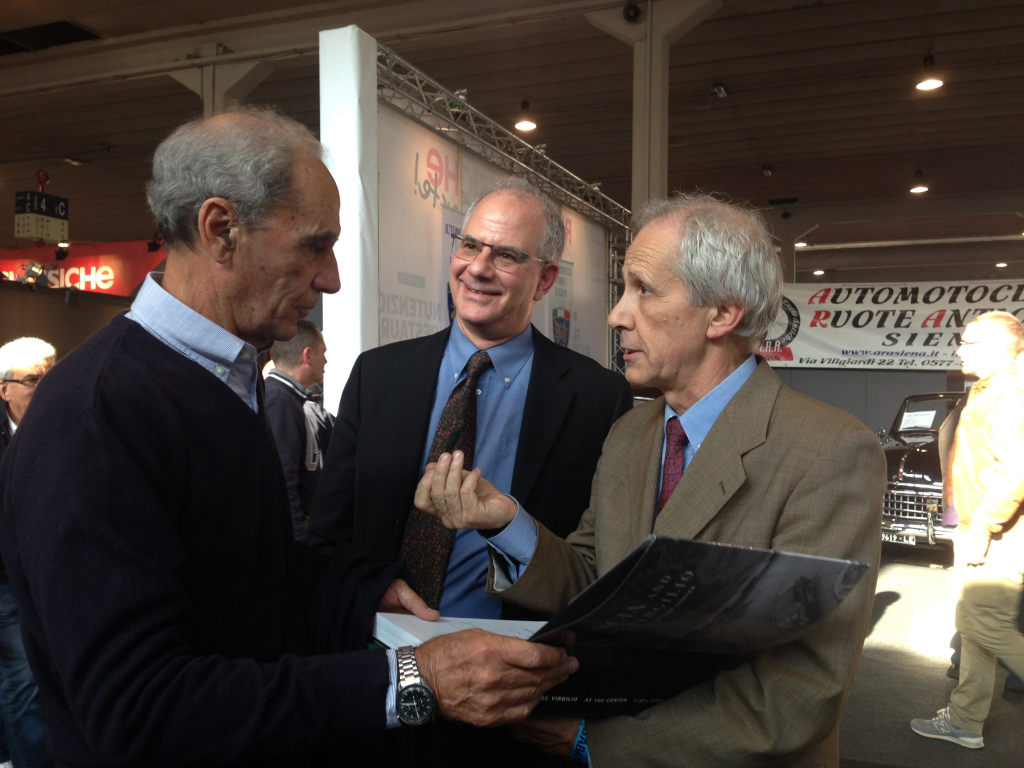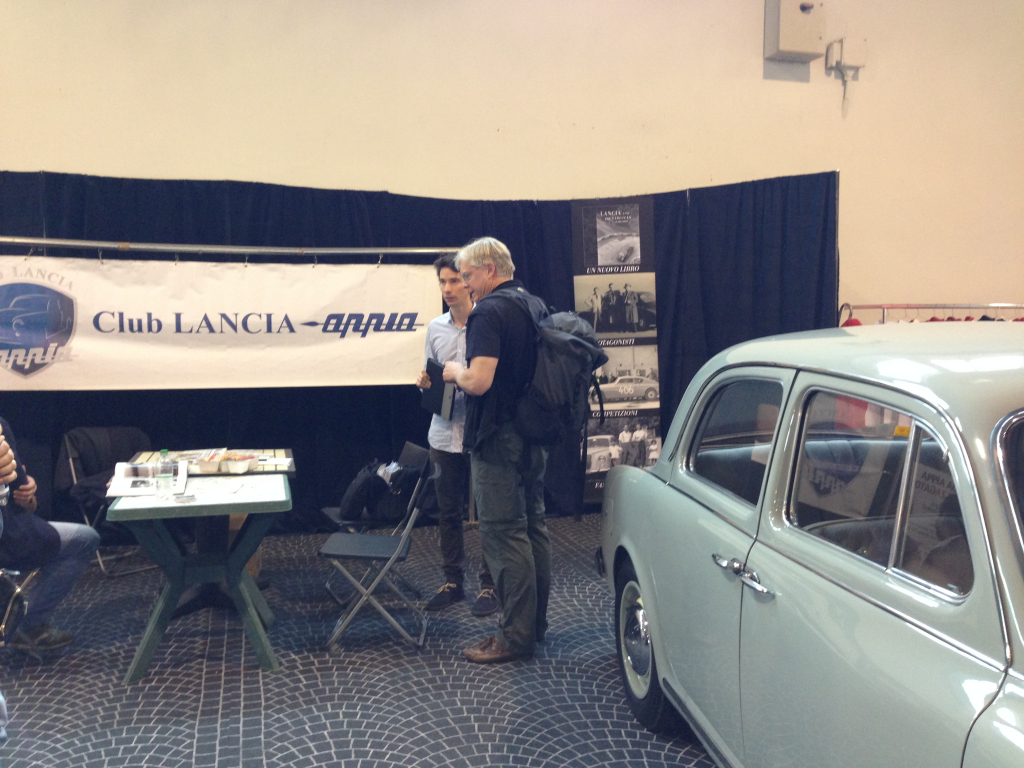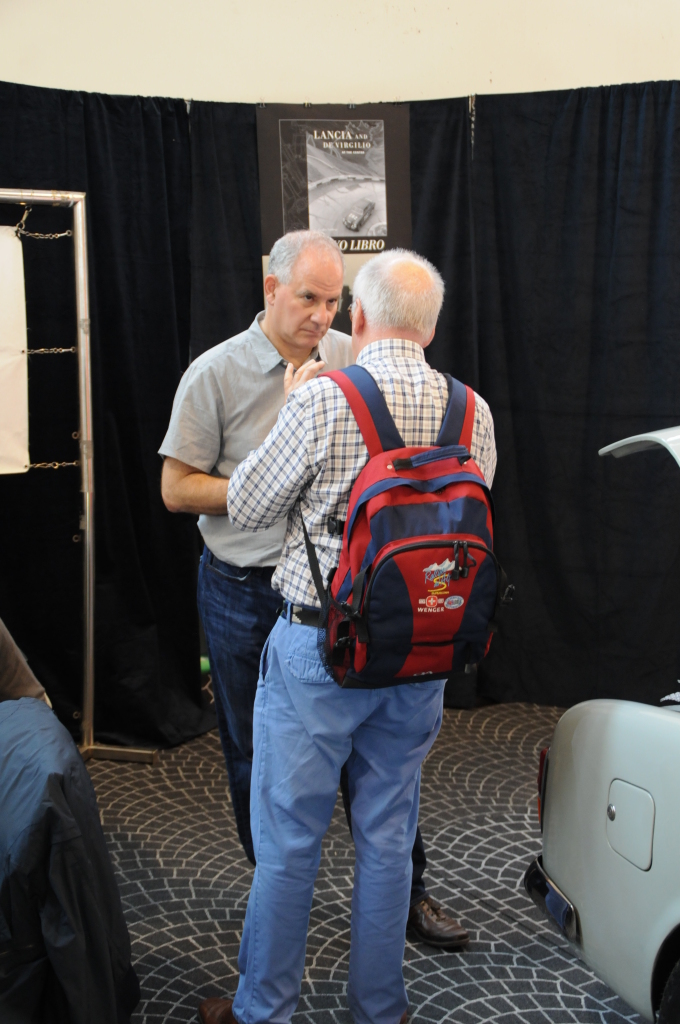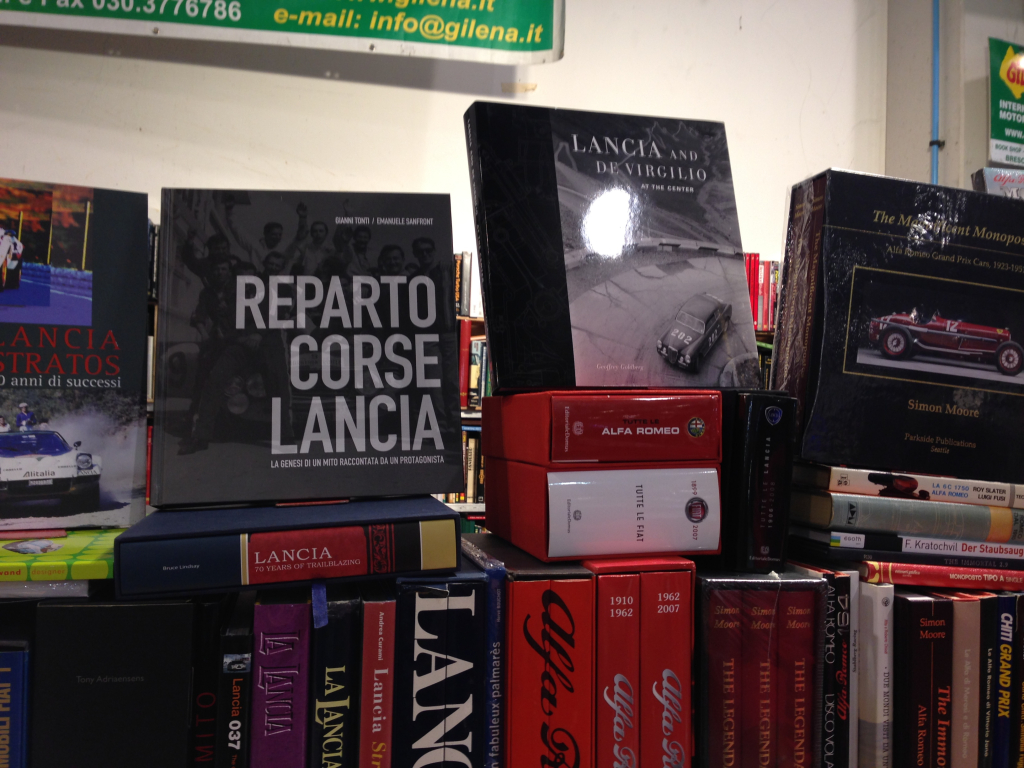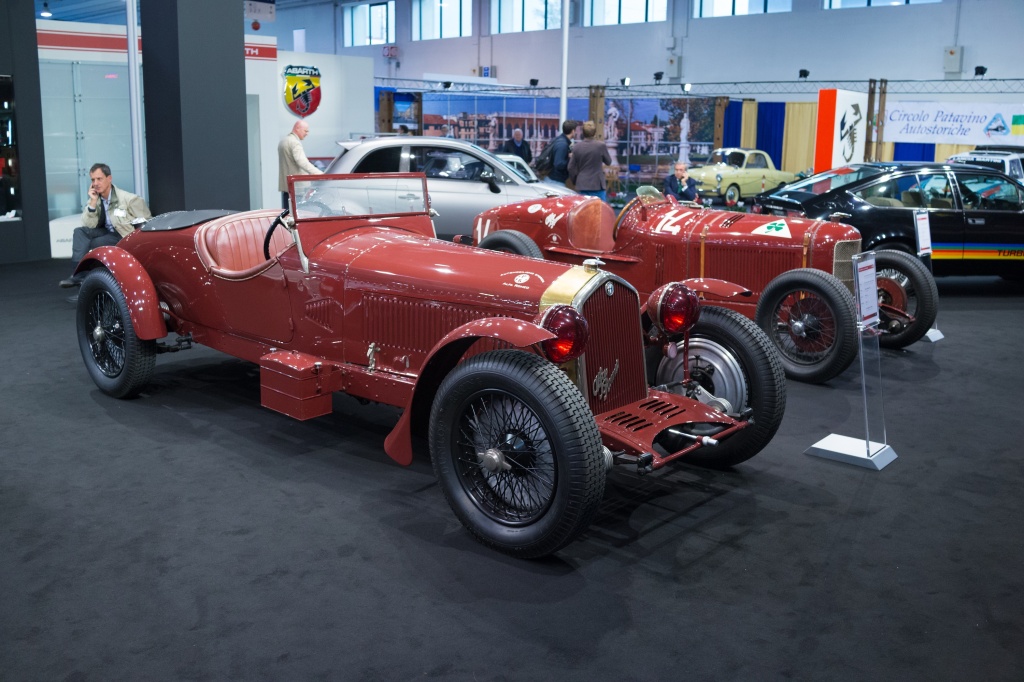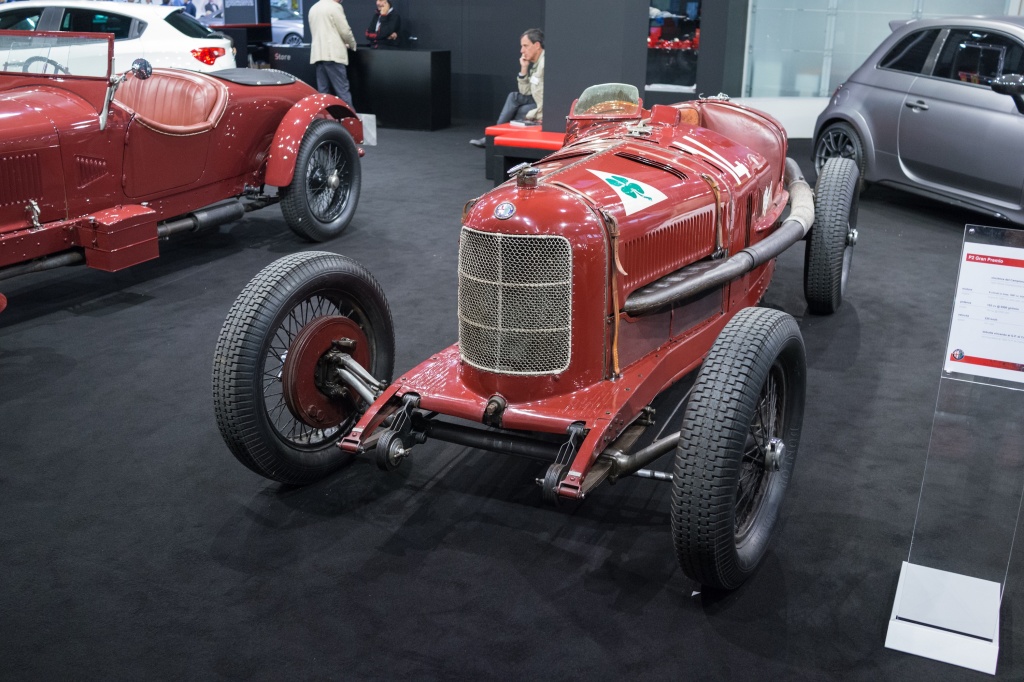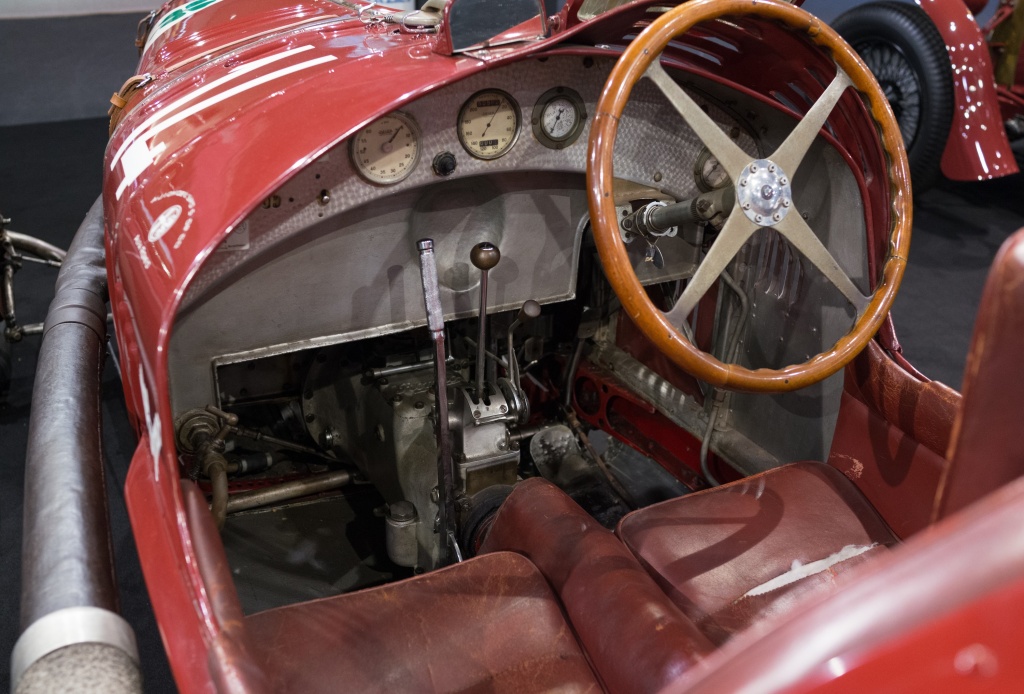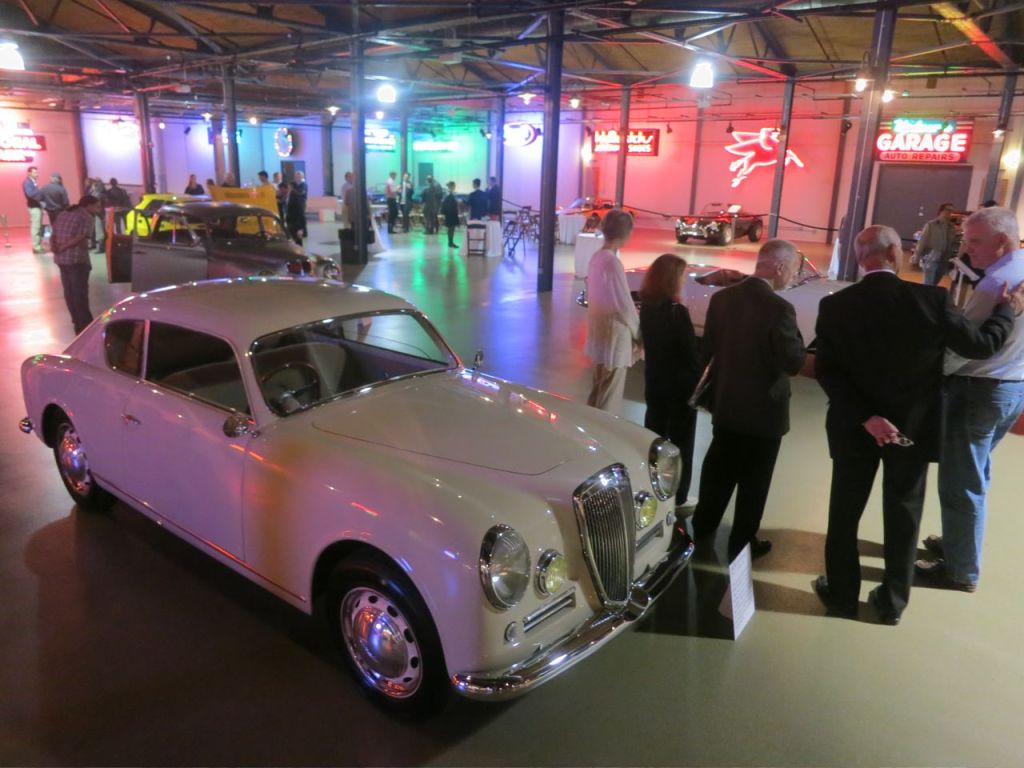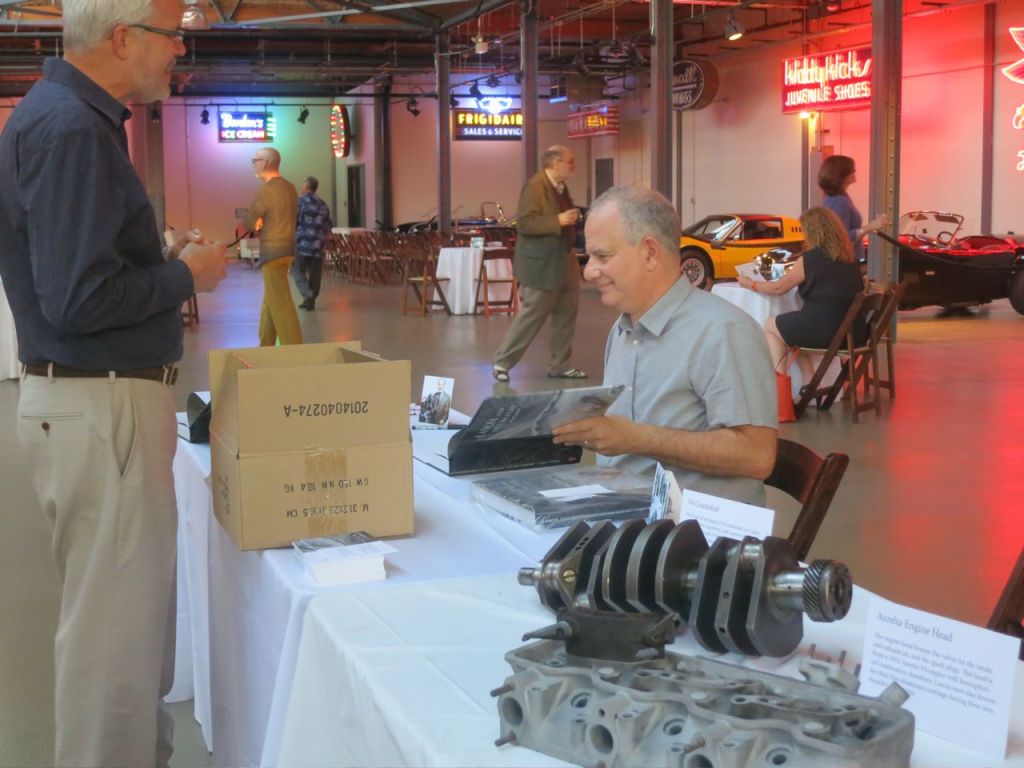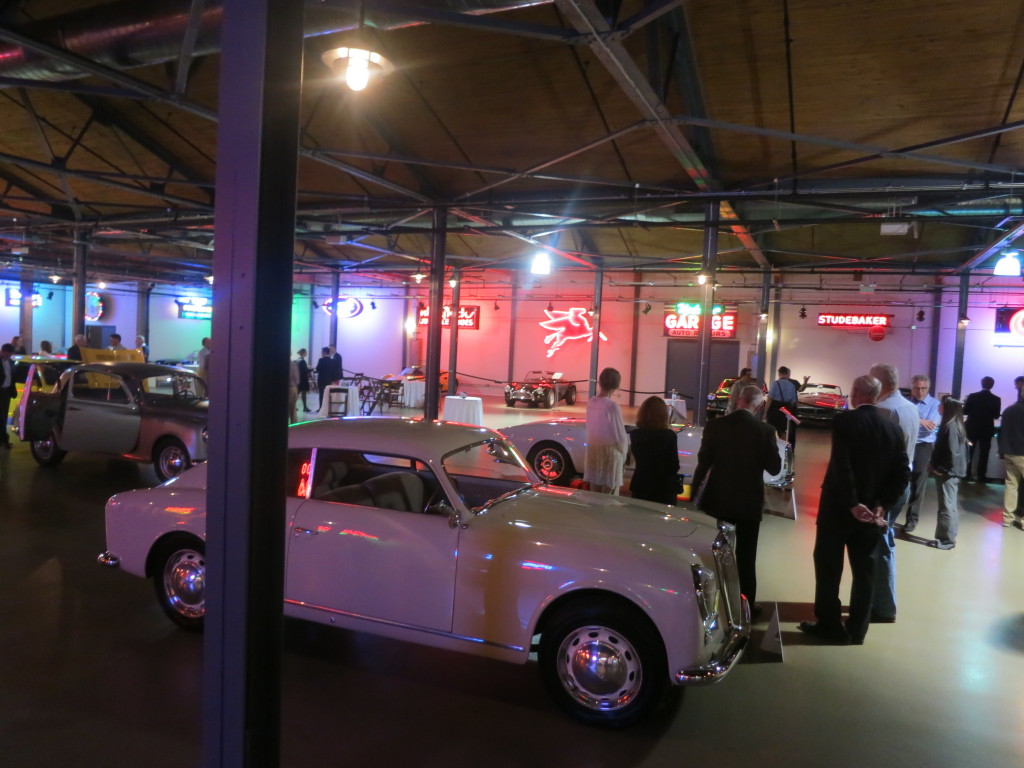Recent Presentations
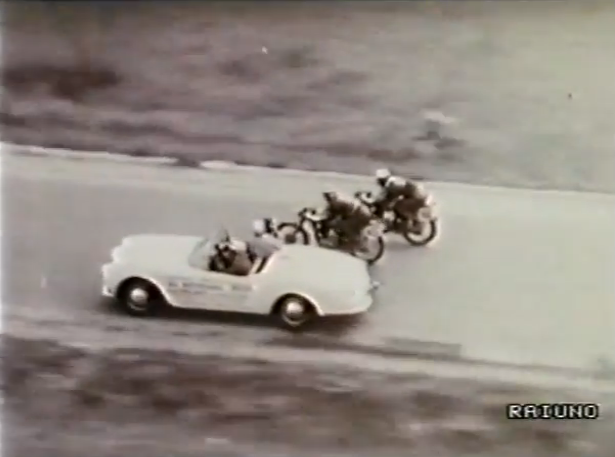
Unseen images presented at the Sliding Pillar – a B24 as photo chase car in the 1955 Moto Giro in Italy
The Sliding Pillar Rally in Molsheim, France, is the premier Lancia gathering of the year. Started in England some 25 years ago by Ade Rudler, the Pillar has grown ever since. It is held every other year in Europe, typically at the end of May, with about 70 older cars present this year. Lambdas, Dilambda, Astura, Artena, Aprilia, Ardea, Aurelia, Flaminia, Fulvia, and Flavias were all present, with people from Holland, Germany, Belgium, France, England, Italy, US, and Australia (probably missing a few). People brought copies of their book for signing, one man having made a wooden box to protect his copy while traveling. The presentation to about 40 people included additional material not in the book, with family shots, more details on engineering aspects, and some racing shots not seen before. Of interest were the shots of the B24 Spider serving as a photographer’s chase car for the Italian Moto Giro.
Another presentation took place on June 30 at The Arts Club of Chicago, a meeting place for those interested in the arts in Chicago with a long history promoting progressive art. A talk was given to about 70 people, covering the high points of the 1950s in the book. The talk was oriented toward design, and Lancia was presented as a model of a mid-sized, fully integrated, design-oriented manufacturing company. Following the presentation, a conversation was led by Michael Darling, wearing two hats: one as Curator of Art of a notable museum in Chicago, the other as a fan of Italian cars. It was fun to have the combination of art and industrial design take place in discussion. People enjoyed the 1950s photos, noting them as delightfully seductive. The presentation was described as follows:

With a full description on the side, the photographer changes his film!
presentation at Watkins Glen
On May 9, a presentation of the Lancia story was made at the IMRCC, or International Motor Racing Research Center, at Watkins Glen in New York state. One of the nation’s leading auto research centers, the IMRCC invites speakers to present interesting topics each month. Watkins Glen (“the Glen”) has a long history of motor racing, hosting Formula One for some 20 years in North America. Local media coverage can be found here: Speaker shares Lancia Stories
Also present was Judy Stropus, a key person in American racing and the auto industry. Apart from looking for speed tips for her 1952 903cc Ardea, Judy shared details of running the 1972 Cannonball “sea-to-shining-sea-memorial-trophy-dash”, one of America’s great racing events.
Battista Falchetto
Lancia’s history is filled with interesting characters, and one most central to the company was Battista Falchetto (1896-1985). He started working at Lancia in 1920, joined the Technical Design Office in 1921, and worked closely with Vincenzo Lancia until his death in 1937. He worked at Lancia Company for 33 years in total, during two separate times: from 1920 to 1943 and from 1953 to 1963. His work in automotive engineering spanned from 1911 to 1964, 53 years in total.
Falchetto’s role at Lancia is interesting to consider. There are several high points -his diary tells of his discussion with Vincenzo in 1921 about the “body as a hull of a boat” idea for the Lambda, the origins of its unit-body chassis, as well as his most famous sketch of 14 independent front suspension alternatives, from which Vincenzo picked the sliding pillar option. Falchetto himself drew up the sliding pillar in detail overnight.
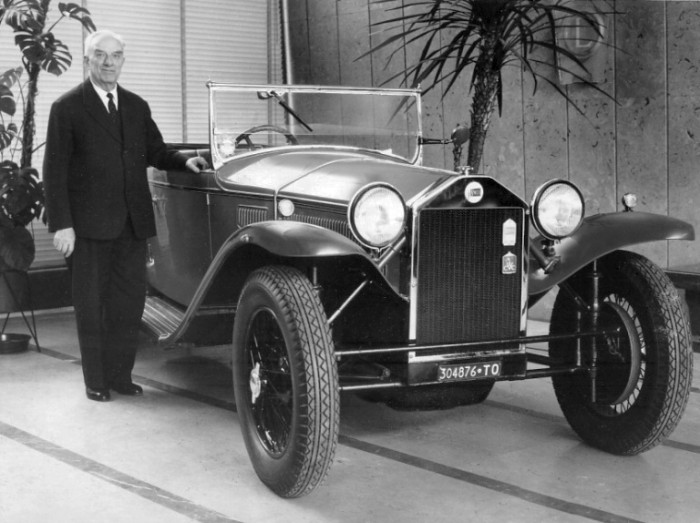
Falchetto and the Lancia Lambda at the Lancia tower in Turin in 1961. He contributed the concepts for the unit-body and the front suspension.
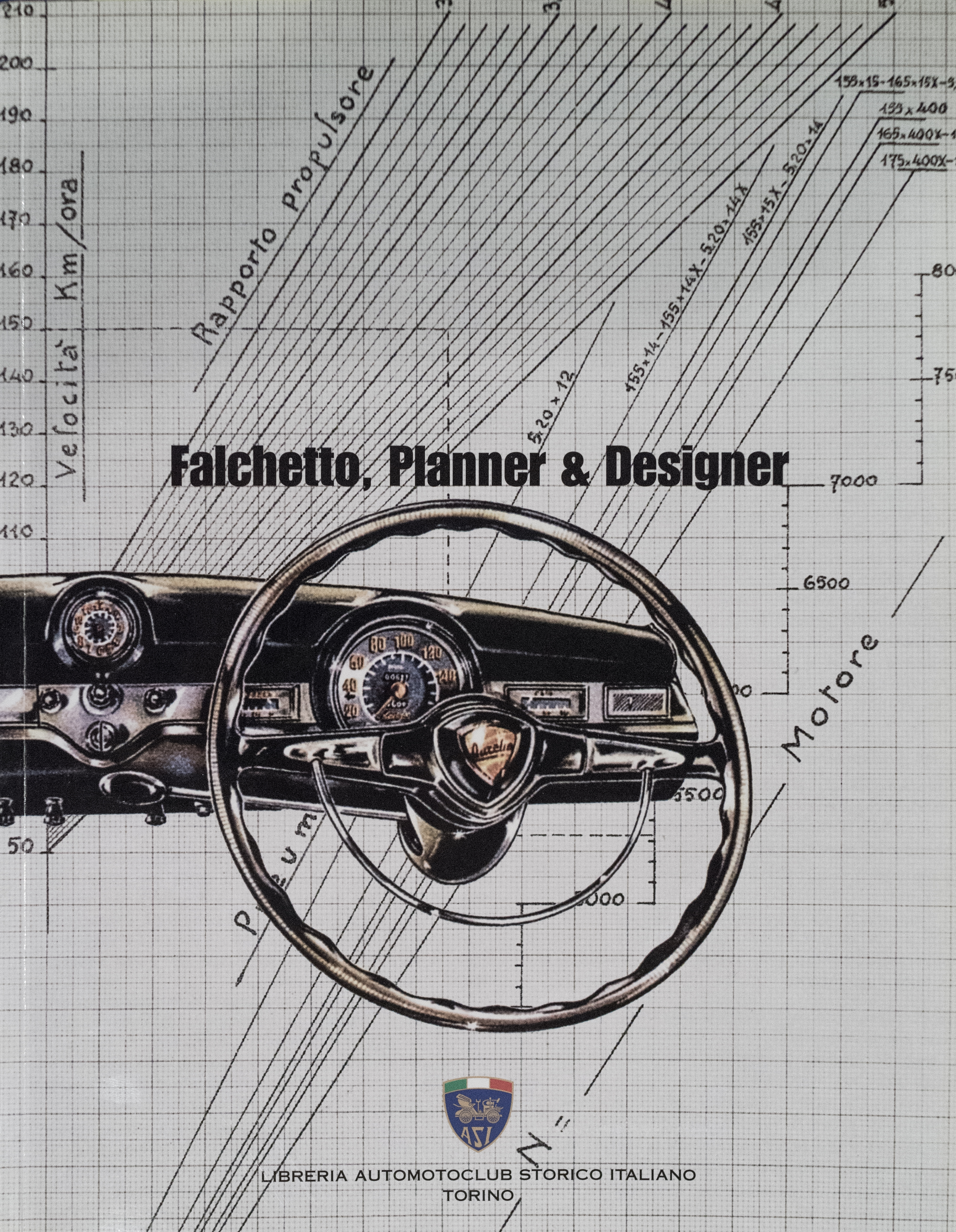
book on Falchetto’s work, including his diaries, a history, drawings and photos, published by his son, Stefano.
His career at Lancia is best understood through his extensive diaries, which convey much of the detail of early company history and personal understandings. They were published by his son Stefano in 2011, as “Falchetto, Planner & Designer” from ASI in Italy. The book is highly recommended to the Lancia buff who wants to understand the underpinnings of earlier Lancias.
His involvement was deep in the heart of the company, responsible for key aspects not easily understood by the car buff, but critical to the company’s profound capacity to make a “whole car”. He was not an engine designer, nor a specialist in one specific mechanical component, such as transmissions, rather he was highly inventive and a thoughtful all-around designer, capable of working on both details and the larger picture, with an understanding of the technical pursuits and interests of Vincenzo Lancia, with whom he worked closely. Without his contributions, Lancias would not have been the cars we cherish so highly today.
Some examples of his work include this famous drawing of the suspension alternatives for the Lambda:
He was in charge of the chassis development for the Lancias – here is his sketch in 1931 refining some of the details for the Dilambda:
And late in life, he developed a very interesting working “abacus”, to correlate the different dimensions of the car, to easily show how changing one relationship would impact others. Very ingenious.
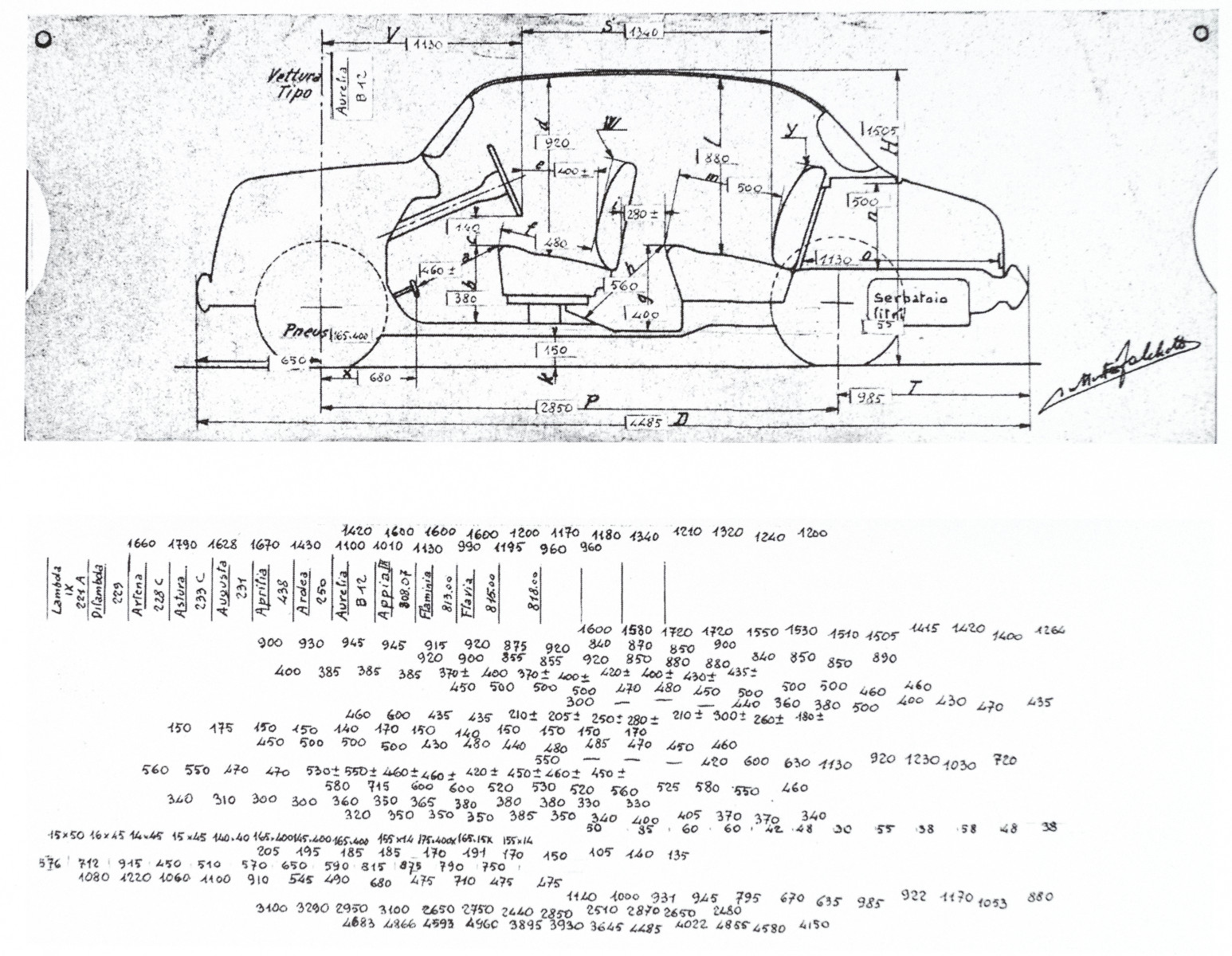
picture of “abacus” for car design, which correlated between different dimensions, signed by Falchetto
Numbering
Understanding Lancia numbering systems is a lesson in archaeology. It takes a bit of time to wrap your arms around the complications, but there is a method behind them. A brief review of four different numbering systems used at Lancia from its beginnings through the 1970s gives a sense of how the company went through different stages and reflects changes in its engineering leadership.
Lancia used engine tipo number from the very beginning, with their Alfa engine of 1907 identified as type 51. The numbers carried through type 66 of the Dikappa of 1921. They were carried forward with the Lambda as 67, 78 and 79 for the different motors, with 68 used for the 1922 Trikappa V8. These engine tipo numbers were used into the 1940s, with the last car motors being the Aprilia as tipo 99 and the Ardea as tipo100. The last production engine to use this numbering system was the tipo 102, the 3Ro motor from 1938.
The earliest engine tipo numbers are strangely the tipo 4 V12 from 1917, with drawings from 1915, followed by the tipo 5, a V12 from 1918. One might wonder why the V12 motors of 1917-8 had lower numbers lower than the earlier car motors. No idea.
Use of the engine tipo numbers continued into the late 1930s and early 1940s, to be used on some prototype motors which are on display in Torino:
- 105 for two 3 cylinder truck motors (1938 and 1940)
- 106 for 4 cylinder truck motor (1937)
The last motor known to have used this numbering system was tipo 111, the 39º V8 prototype (c. 1942), identified in De Virgilio’s notes from 1943.
The cars themselves had a different numbering system for their chassis, independent of the motor numbering. The Lambda was from car type 214 to 222A (the different numbers were used for each series), the Dilambda 227. This system extended through the 1930s as well: the s.1 Aprilia was 238, the chassis 239, and the s.2 Aprilia was 438. Acccordingly, the 1945 45º V6 replacement for the Aprilia was called the 538, its number at that time coming from the Aprilia car. This system ended with the Ardea, with the s.1 Ardea as 250, with later Ardeas as 350, 450, 550, 650, reflecting an intent to rationalize (futile, surely!).
In 1943, the system is changed when Jano is put in charge of all the engineering; he used a new approach, with A for large cars, B mid sized, and C small, with D used later for the racing cars, and later worked to have 10 as the berlina, 20 as the coupe, etc. Car and motor numbers now to be the same, so the A10 car had an A10 motor, and De Virgilio’s work on the Aurelia was the B10 motor, and later on a C10 motor for the Appia. The s.2 Appia of the late 1950s was Lancia’s last car to use Jano’s numbering system.
In 1955, Fessia arrived and changed the numbering system again, to now start with a three digit number, beginning with 8. The Appia s.2 (introduced in 1956) was still called the C10, but drawings from early 1957 were labelled with both C10 and 808 numbers, a sign of the transition. The first new car with Fessia’s numbering was the Flaminia (813) from 1957. His numbering was extended to the Flavia (815) and Fulvia (818), and survived long after his decease in 1968, to be used for the Stratos (829) and the Delta, Thema and Dedra into the 1990s.
Color update – Glasurit and Lechler now online
Finding the right color for your old Lancia has always been a challenge. Original period paint samples are quite rare, and even they have faded with time. Another way is to find some hidden bit of original paint on your car, not aged in daylight, and use that to establish the paint color, but that is not so easy either. Ideally, someone has researched the historic Lancia paints.
Paints for the 1960s Lancias were listed in the workshop manuals, and for the Flavia and Fulvia, the paint colors are more readily accessed. However, Lancia was in the process of changing paint systems at the time, and some of their favorite paint manufacturers, Max Meyer, do not have cross-indexing to other more current paint manufacturers. Its even harder for the older cars.
In 1990, Lechler (a European paint company) published current paint codes for vintage Lancias. That list was a key milestone in efforts to reconcile past and present paints and can be found elsewhere on this blog (search under “color”). However, Lechler paints are not available in the US (the one Canadian distributor is non-responsive) and so there is no way here in the US to know if their new paint colors truly match up with the older paints.
Since then, the paint world has made some strides. Lechler has now made their vintage paint selector available online. Go register on their site, type in Lancia, and up pops a wide list of paint colors used on Lancias. They give dates for when the paint color was used, and they look reasonable at first glance, but no guarantees. Its complicated, but its possible to get the paint mix from this site. Again, I’ve never seen a Lechler paint sample, so I have no idea how close it is to the original, but you can even order a spray can of it, and try it out.
Lechler paint explorer
spray can samples from German
Glasurit has long been active in paints and has a good US presence. THere are a few Glasurit paint chip cards around from the 1980s that list paints (and in some cases, even a formula) going back to the 1960s. Its still a bit tricky as Lancia used different mixes for some of their standard colors (even for Lancia blu) so you have to pick the right one for your car.
Glasurit now publishes their paints for vintage cars online also. Their site is tricky to navigate, with over 100 paints listed, but for many its possible to get the color formulas. In some cases, multiple listings are provided for a color (for different eras) reflecting that they too (like Lechler) are aware that the original color formulas were modified by Lancia over the decades.
Glasurit color on line
Things to look for
There are three things to look for in the new paints: color and sheen (level of shine) are most widely understood. However, one more factor, the depth in the look, should be taken into consideration. This last one is probably a function of the paint system but its worth considering when you are thinking of new paints. When urethane paints first came to the market, early applications were rather thick and didn’t look right, but by now, a skilled applicator can make them really look much closer to the original so that their use is not a problem. They aren’t quite as deep, nor lay as thin as the old nitro-cellulose lacquer, but they are available, durable and easily repaired. I have this on my B20 and am quite happy with it.
New York Times calls De Virgilio “the da Vinci of the V6”
On Dec. 14, the NYT ran a story on De Virgilio and the V6 engine, as the engineer and writer Kevin Cameron explained the importance of this engine and how its design was solved at Lancia in the 1940s.
Apart from enjoying the coverage of De Virgilio and Lancia, in itself the story is worth considering. Imagine a national media outlet, in fact the most important in the US, writing about an engine design from 70 years ago. This says a lot about our current interest in design and the NYT.
An extensive slide show, with many images from Lancia and De Virgilio, is available on-line: Working in Postwar Italy, He Was the da Vinci of the V6
One-rod engine
 One of the more interesting aspects of engine design are the ideas that don’t work.
One of the more interesting aspects of engine design are the ideas that don’t work.
De Virgilio, father of the Aurelia V6, also tried the unusual. His One-rod engine, shown in this new drawing by Luigi De Virgilio, was for a vertical square-4 cylinder arrangement radically different from any other conventional automotive engine. Its best described as a pair of parallel twins, each coupled by an internal rocking arm, with a single rod running vertically to a very short crankshaft. It was a very compact engine to provide maximum interior space in the upcoming Appia.For additional details, see Lancia and De Virgilio, At the Center.
Book reviews
Lancia and De Virgilio, At the Center has been reviewed broadly:
New York Times
On Dec. 14, the NYT published an extensive article on De Virgilio, giving him proper credit for the design of the V6 engine. Kevin Cameron (a very learned engineer) called him the da Vinci of the V6, discussing engineering, Lancia as a company and De Virgilio as a designer, writing:
“De Virgilio’s career is chronicled in a new, generously illustrated book, “Lancia and De Virgilio at the Center,” by Geoffrey Goldberg (David Bull Publishing, 2014). The book has the graceful quality and range of an artist’s biography, properly treating De Virgilio’s entire life as relevant to his work. He is depicted with his family, at work and at the racetrack.”
The article and a slide show of images from the book can be found at:
Working in Postwar Italy, He Was the da Vinci of the V6
Italian Press: la Repubblica
Following the NYT article on Dec. 14, 2014, the Italian newspaper la Repubblica ran an article on the book on Dec. 26. Their review was written by Alfio Manganero, who worked for Lancia in the 1980s and knew the engineer: De Virgilio, “il Leonardo da Vinci del motore V6”
>De Virgilio, “il Leonardo da Vinci del motore V6
Classic and Sports Car
In September, 2014, they called it their “book of the month” :
“The design of the fabulous Lancia Aurelia is often credited to Vittorio Jano, but this quality volume sets out to highlight the key contribution made by the little-known engineer Francesco De Virgilio, who married the niece of Lancia founder Vincenzo. Dedicated marque fanatic Geoffrey Goldberg, a Chicago-based architect, has dug deep with six years of research that included access to the engineer’s family archives in Turin.
As well as an in-depth study of the V6’s development through a wealth of design sketches, blueprints, and testing records, Goldberg also covers the Aurelia’s often colorful competition career, as well as De Virgilio’s work on the D50 Grand prix machines, the Appia, and the Stratos.Continuing David Bull Publishing’s high standard of design, this handsome title is beautifully produced, and has a wealth of never-before-published photographs of life inside Lancia. A vivid insight into the career of a 1950s automotive engineer.”
Motor Press Guild
This group reviews the automotive books each year, awarding the best the “Dean Batchelor Award for Excellence in Automotive Journalism.” Lancia and De Virgilio, At the Center was one of three finalists in December, with this year’s award going to Black Noon: The Year They Stopped the Indy 500 by Art Garner.
VeloceToday
in October, this on-line site published two reviews, one by Nigel Trow, the other by the site editor Pete Vack. There were also some interesting comments following the reviews.
Nigel Trow on Veloce
Lancia and The Great Divide by Pete Vack
Nigel Trow’s penetrating review includes a lot of information, and it is recommended that one read it in its entirety. Here are excerpts from it:
“Geoff Goldberg’s illuminating book, Lancia and De Virgilio – At the Center, fleshes out those conversations wonderfully, providing an unusually intimate portrait of the man and the company during the last decade of Lancia family ownership. This is the proper stuff of history, which always concerns human activity and its consequences. Happily, this newest addition to Lancia literature offers not only significant insights into the company itself, but is an example of how the whole field of automobile history might be re-vivified.
It begins with people, with charming, beautifully printed pictures of the deeply Piedmontese Lancia family absorbing a young Calabrese engineer, Francesco De Virgilio, through his marriage to Rita, niece of Vincenzo, the company’s founder. However, despite becoming a member of the Lancia family early in his career, he was never privileged, achieving his importance to the company through the creative inventiveness and competence meticulously documented by Goldberg.
In concentrating on a single, previously unsung engineer and his lifetime’s work for an historic Italian motor manufacturer, this beautiful book emphasizes the place of the personal in industrial life. The best known of his many achievements was the successful balancing of the V6 crankshaft, a tale Goldberg tells with the enthusiasm of a lifelong Aurelia owner. He also proves to be a generous author, as the inclusion of John Cundy’s succinct technical account of this matter ably demonstrates. Incorporating this engineering essay, written in layman’s language, is characteristic of the fluid format of the book, which moves out from a conventional linear time line to a more relational pattern where differing aspects of De Virgilio’s life and work come together outside the chronology.
…Lancia and De Virgilio is a distinctive labour of love framed by scholarship. It is particularly distinctive in its generous use of De Virgilio’s sketches, workings-out and correspondence, which, coupled with fine reproductions of factory engineering drawings extend the readers understanding and pleasure. The sheer volume of fresh and stimulating material gathered together by the author and his collaborators is remarkable, providing any serious student of automobile history with much to think about, and question. The extensive, well laid out references are ample demonstration of his intention.
It would be optimistic to hope that many books such as this might be published in the future. The web’s offer of instant gratification is too strong, and e books give easy, inexpensive information. They never provide the pleasures of texture, weight and heft found here, however. Lancia and De Virgilio is for book lovers as well as petrol heads. If my own forthcoming book, Maserati – The Family Silver, shares half its qualities, I shall be a happy man.”
Australian Lancia Club,
In July, 2014, the book was reviewed by Bill Jamieson (author of the highly regarded Capolavoro on the Lambda), with an excerpt below:
“In short, this is a book to be recommended. The writing style is fluent; the research is careful and detailed; the illustrations are abundant and well-chosen; the index is comprehensive. Of course, every Aurelia owner should have a copy, but it is equally attractive to all those with an interest in the Lancia story.”
Australian Lancia Club review
Vintage Motorsport,
In their Nov./Dec. 2014 issue, Steve Snyder wrote the following comments:
“Why write a book focused on the postwar history of Lancia, one of Italy’s great automotive manufacturers and relate this era to a designer-engineer? Four years after joining Lancia in Feb. of 1939, Francesco De Virgilio took the challenge of making a previously unusable V-6 engine to run smoothly by designing it with correct balance. The success of this endeavor led to the production of the world’s first V-6 in the Lancia Aurelia in 1950. With De Virgilio’s further development, this engine powered a series of international race winning Lancia cars. To document and write this history, Geoffrey Goldberg spent many years in research primarily by having won the confidence of the De Virgilio family in Torino, Italy. This original material gives this book it’s credence. In keeping with Grif Borgeson’s approach in his book Bugatti (1981), Geoff has gone directly to the source thus no mythology or fluff.”
Victory Lane, October 2014, Dan Davis:
“This book presents the very very detailed and illustrated story of family, corporate and technical decisions as few other books ever have. It is based on volumes of De Virgilio’s papers, as well as Lancias’s archives. This is a book to read and save as a great automotive technical and human story.”
Motorsport, October 2014, unsigned:
“When I first drove a Lancia Aurelia I was astonished at how sophisticated it was. Much of the credit belongs to Francesco De Virgilio, a brilliant Lancia engineer whose career spanned wartime scout vehicles up to the LC2 GpC prototype. Engineers aren’t much in the spotlight, so it takes a book like this to illuminate the hidden genius of a man like De Virgilio, who solved the problems of the V6 engine, devised anti-roll suspension, built race engines, worked on a 4WD system for the D50 Grand Prix car, and planned the early Stratos. Using much personal material including notebooks, sketches and many drawings this is heavily focused on the technical, carefully explaining the balance problems De Virgilio defeated for the Aurelia engine, and if your physics isn’t strong you’ll struggle. But generous photographs, especially in the section on his personal life, well illustrate the life of a man who worked with Jano and Villoresi, whom Ferrari tried repeatedly to poach, and who put as much effort into truck engines as racing units. Production quality is up to Bull’s usual high standards.”
Amazon
They have a few reader comments, fun to read, one of the comments reads:
“Most complete and thorough book on the subject I have yet seen. A technical book and an historical book disguised as a biography. Very well done.”
Lancia and De Virgilio on Amazon
Book Introduction – Italy
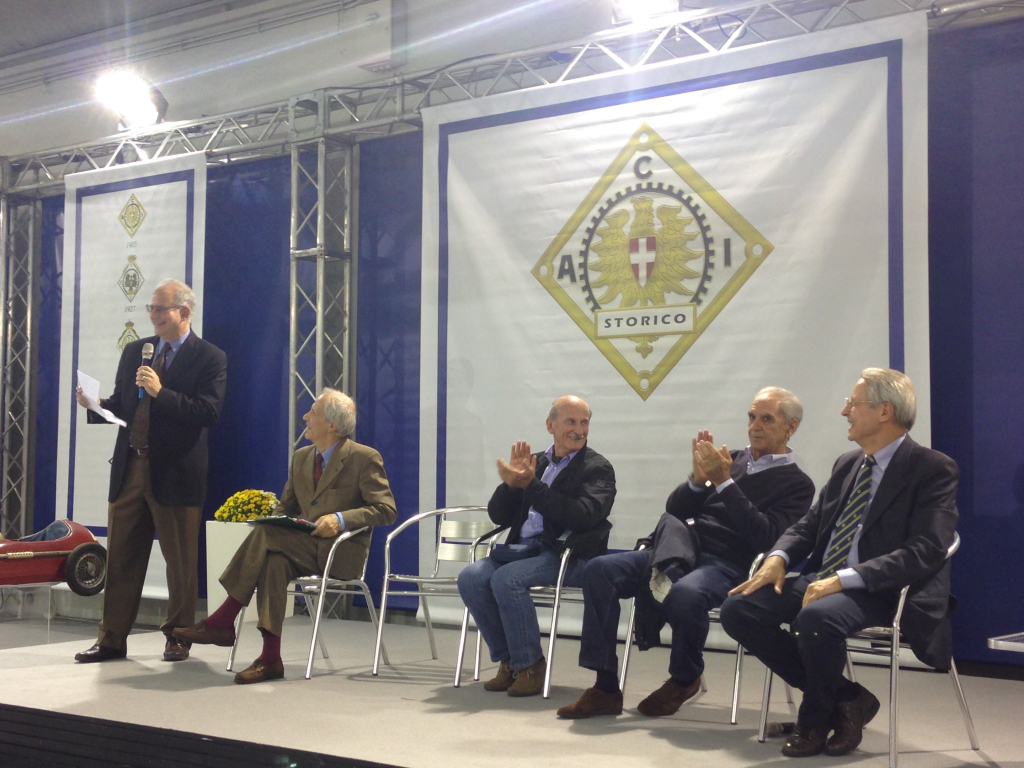
The Padova presentation, delivered in Italian, and happily completed, with Luigi De Virgilio, Gianni Tonti, Sandro Munari and Giovanni De Virgilio onlooking.
October in Italy is known in the car world for the massive fair at Padova. Dedicated to older Italian cars, there are people showing parts and literature, cars for sale and anything else that might surround those activities. Serious players in the car world are present, including both Alfa Romeo (with their race cars from the 1930s) and Mercedes Benz (with the 300 SLR that looked very much like the one of Stirling Moss and Dennis Jenkinson in the 1955 Mille Miglia), as well as numerous car clubs and organization.
The Automobile Club of Italy (ACI) invited the De Virgilios and me to present the book at the fair. We asked Gianni Tonti to join us in our presentation in front of about 60-70 people. As we were in Italy, the presentations (including mine) were in Italian, much to everyone’s amusement. By happenstance, we were also joined by Sandro Munari, famed Lancia rally champion from the 1960s and 70s. This was wonderful as he was a childhood hero of mine. Munari is interested in the recording of the history of those times, and was quite delighted to see the book. We made our home at the fair at the Appia Club, an Italian group of passionate Lancisti where everyone could collect. My thanks to Matteo Zambelli for hosting us!
The Padova fair is rather a remarkable place – with some 14 exhibition halls and much remarkable material. This being Italy, the numerous rooms of car parts, models, literature and cars were also accompanied by chocolate stands, clothing, grappa vendors, and merchants of kitchen equipment, scattered among Flaminia crankshafts and carburetors too many to name. I was able to find a letter written by Vittorio Jano from 1956, and a complete Nardi catalog from 1962, but passed on a Pentaiota owners manual from the 1920s.
The book is now available at several dealers in Italy, including Gilena and Libreria dell’Automobile (Giorgio Nada) in Milan. They were pleased to see the book, but were eager for an Italian translation. It is not clear if the audience is big enough for the effort that would be required, but it is being considered – possibly as a separate text document.
We had a Lancia dinner at Padova with many committed Aurelia fans, from Italy, throughout Europe, and the US. With some 27 people, it was a most enjoyable time. Beppe Reggazoni told of having Aurelias in Cambodia in 1959-1962 but also seeing the Lancias in the 1951 Mille Miglia. Eugenio Sgaravatti was there, having shown his Aurelia B50 at the fair, an unrestored car in his family since new.
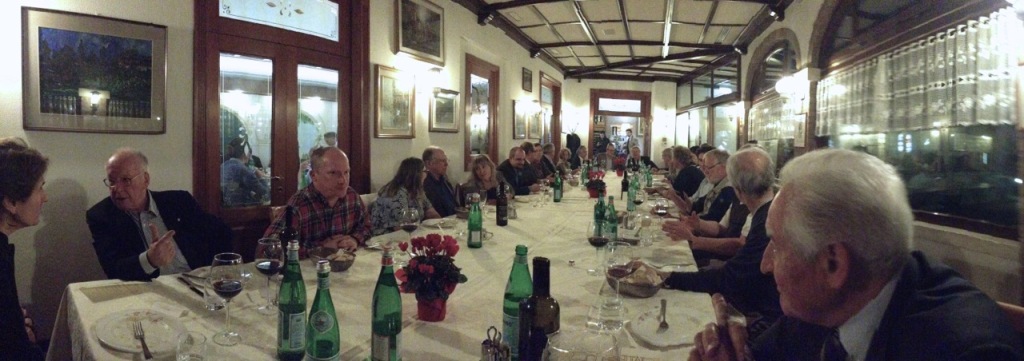
Dinner with Joachim Griese, Wayne Kelham, and the Steerman family on the left, with Beppe Regazzoni, Luigi De Virgilio and Niels Jonassen on the right. Giovanni De Virgilio and Sebastien Simon are at the far end.

Matteo Zambelli, Martin Willems, Geoff and Chiara Vismara on the left, and Getulio Ferri (Jet) and Tom Frisardi on the right.

A stunning Lancia Artena limousine for sale. 4500 lbs, and a 4 cylinder, 2 liter motor from 1940 is not a recipe for high performance, but it was beautiful.
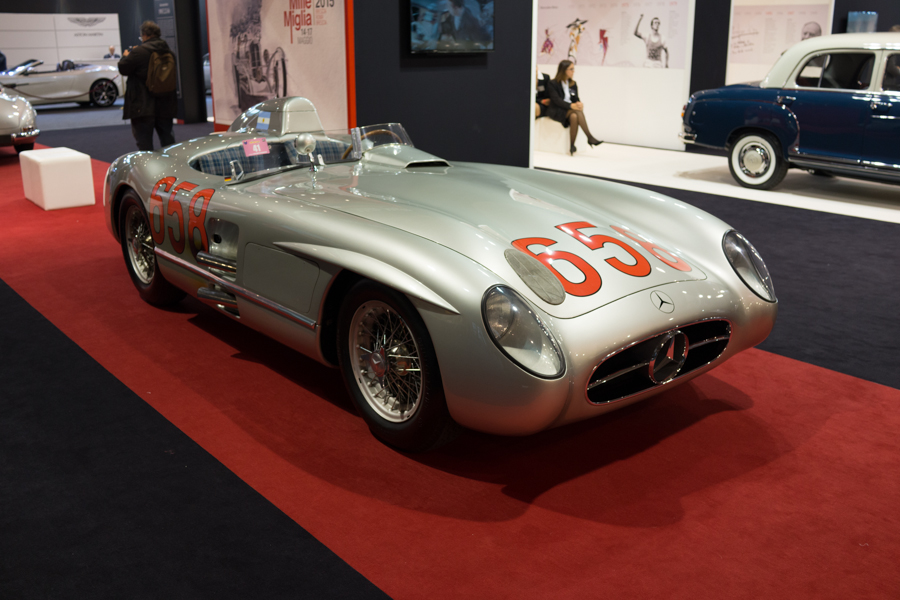
Mercedes 300 SLR
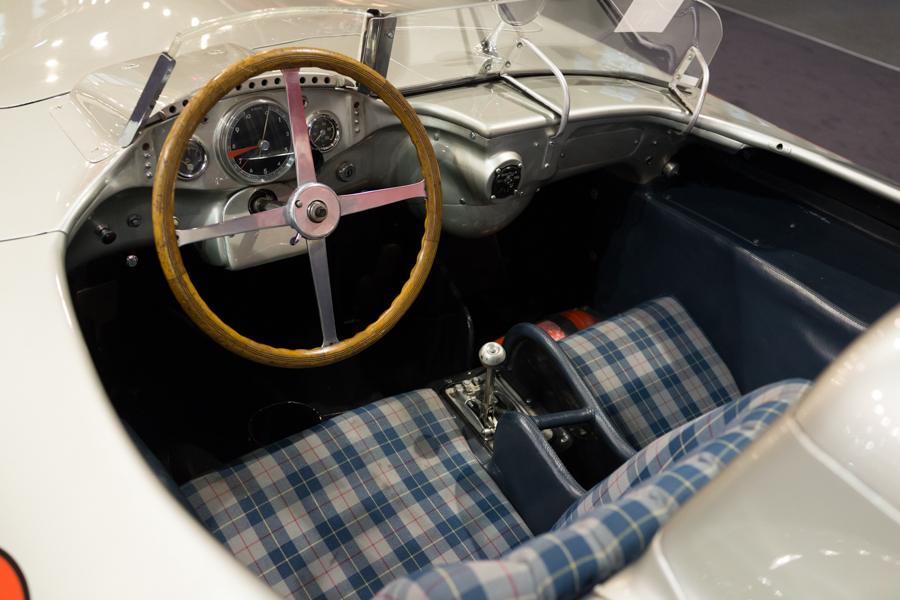
Book Party – nice time had by all.
Book party was a roaring success: about 130 people came, and many books left to new homes. The setup was lovely with a B24 Spider, a B20, an Appia sedan, Fulvia coupe and Delta Integrale on display. See pictures at:
In the room were also cars from the lovely Joe Hayes Collection. Geoff gave a book presentation, people enjoyed the broader historical issues that were part of the project. Trinkets were on display, with a V6 crankshaft and engine parts, of much interest.
Folks came from all over – from Indianapolis, Minneapolis, and several from Wisconsin. Welcome all! All in all, a good night. Nice beginning for the book, and thank you Chicago!


